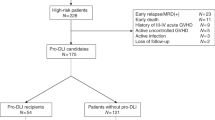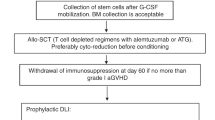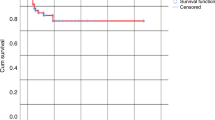Summary:
Haploidentical transplantation has become a clinical option for patients lacking a compatible donor. However, patients are still referred at advanced stages and are usually heavily pretreated. This results in a high risk of toxicity, relapses and infections. We therefore started a donor lymphocyte infusion (DLI) dose-finding protocol, to try to improve both relapse rate and immunity reconstitution. In all, 12 consecutive patients were investigated. All had a refractory, some progressive, disease. Conditioning consisted of TBI, melphalan, ATG, fludarabine and CSA pretransplant. In four rapidly progressive patients, Ara-C had to be given 1 week preconditioning. The graft was T- and B-cell depleted with a fixed reinfused CD3 dose of 5×104/kg. All patients engrafted before day 20. G-CSF was given from day 5 post-transplant and replaced with GM-CSF in the last three patients. Nonrelapse related mortality was 0/12 at 1 year. DLI were started at day 28 (3×104 CD3/kg) in the two first patients. This resulted in acute graft-versus-host disease (aGVHD) and chronic graft-versus-host disease (cGVHD) in both, but they did not relapse. The next dose was 1×104/kg monthly for 3 months. This was well tolerated with only one grade I GVHD. Given the high relapse rate, we escalated doses (1, 3 and 10×104/kg). This produced GVHD in all. We next moved, to GM-CSF and 1×104 CD3/kg monthly. Overall, 6/12 patients relapsed and received therapeutic DLI, starting at 1×105 CD3/kg with escalation every 2 weeks. We conclude that prophylactic DLI are feasible in adult haploidentical transplantation, without GVHD at a monthly dose of 1×104 CD3/kg. They result in faster CD4 recovery and a low rate of infections. The impact of GM-CSF remains to be further investigated. This scheme seems ideal for patients transplanted early in the course of their disease. In very bad prognosis patients, it remains insufficient to rapidly induce a GVL effect. Escalated doses are feasible but the price is aGVHD. Therapeutic DLI can be given at higher doses, depending on the time post-transplant. Haploidentical transplantation with low-dose DLI is a safe procedure that should be considered in all patients needing a transplant, but lacking a matched donor, early in the course of the disease.
This is a preview of subscription content, access via your institution
Access options
Subscribe to this journal
Receive 12 print issues and online access
$259.00 per year
only $21.58 per issue
Buy this article
- Purchase on Springer Link
- Instant access to full article PDF
Prices may be subject to local taxes which are calculated during checkout


Similar content being viewed by others
References
Aversa F, Tabilio A, Terenzi A et al. Successful engraftment of T-cell-depleted haploidentical ‘three-loci’ incompatible transplants in leukemia patients by addition of recombinant human granulocyte colony-stimulating factor-mobilized peripheral blood progenitor cells to bone marrow inoculum. Blood 1994; 84: 3948–3955.
Aversa F, Tabilio A, Velardi A et al. Transplantation for high-risk acute leukemia with high doses of T cell-depleted hematopoietic stem cells from haploidentical ‘three loci’ incompatible donors. N Engl J Med 1998; 339: 1186–1193.
Champlin R . Bone marrow transplantation for leukemia utilizing HLA-matched unrelated donors. Bone Marrow Transplant 1993; 11 (Suppl 1): 74–77.
Ruggeri L, Capanni M, Urbani E et al. Effectiveness of donor natural killer cell alloreactivity in mismatched hematopoietic transplants. Science 2002; 295: 2097–2100.
Lowdell MW, Craston R, Ray N et al. The effect of T cell depletion on immune reconstitution after chemotherapy and allogeneic bone marrow transplantation as treatment for leukemia. Bone Marrow Transplant 1998; 21: 679–686.
Ruggeri L, Capanni M, Casucci M et al. Role of natural killer cell alloreactivity in HLA-mismatched hematopoietic stem cell transplantation. Blood 1999; 94: 333–339.
Goldman JM, Gale RP, Horowitz MM et al. Bone marrow transplantation for chronic myelogenous leukemia in chronic phase: increased risk for relapse associated with T-cell depletion. Ann Intern Med 1988; 108: 806–814.
Arpinati M, Green CL, Heimfeld S et al. Granulocyte-colony stimulating factor mobilizes T helper 2-inducing dendritic cells. Blood 2000; 95: 2484–2490.
Bober LA, Grace MJ, Pugliese-Sivo C et al. The effect of GM-CSF and G-CSF on human neutrophil function. Immunopharmacology 1995; 29: 111–119.
Velardi A, Varese P, Terenzi A et al. Lymphokine production by T-cell clones after human bone marrow transplantation. Blood 1989; 74: 1665–1672.
Hartung T . Anti-inflammatory effects of granulocyte colony-stimulating factor. Curr Opin Hematol 1998; 5: 221–225.
O’Garra A . Cytokines induce the development of functionally heterogeneous T helper cell subsets. Immunity 1998; 8: 275–283.
Sloand EM, Kim S, Maciejewski JP et al. Pharmacologic doses of granulocyte colony-stimulating factor affect cytokine production by lymphocytes in vitro and in vivo. Blood 2000; 95: 2269–2274.
Gerritsen EJ, Stam ED, Hermans J et al. Risk factors for developing EBV-related B cell lymphoproliferative disorders (BLPD) after non-HLA-identical BMT in children. Bone Marrow Transplant 1996; 18: 377–382.
Volpi I, Perruccio K, Tosti A et al. Postgrafting administration of granulocyte colony-stimulating factor impairs functional immune recovery in recipients of human leukocyte antigen haplotype-mismatched hematopoietic transplants. Blood 2001; 97: 2514–2521.
Jacquy C, Soree A, Lambert F et al. A quantitative study of peripheral blood stem cell contamination in diffuse large-cell non-Hodgkin's lymphoma: one-half of patients significantly mobilize malignant cells. Br J Haematol 2000; 110: 631–637.
Acknowledgements
This study has been made possible thanks to funding by a grant from ‘Les Amis de l’Institut Bordet’ and a grant from the ‘FNRS-Télévie’.
Author information
Authors and Affiliations
Rights and permissions
About this article
Cite this article
Lewalle, P., Triffet, A., Delforge, A. et al. Donor lymphocyte infusions in adult haploidentical transplant: a dose finding study. Bone Marrow Transplant 31, 39–44 (2003). https://doi.org/10.1038/sj.bmt.1703779
Received:
Accepted:
Published:
Issue Date:
DOI: https://doi.org/10.1038/sj.bmt.1703779
Keywords
This article is cited by
-
Beneficial role of CD8+ T-cell reconstitution after HLA-haploidentical stem cell transplantation for high-risk acute leukaemias: results from a clinico-biological EBMT registry study mostly in the T-cell-depleted setting
Bone Marrow Transplantation (2019)
-
Post-relapse survival after haploidentical transplantation vs matched-related or matched-unrelated hematopoietic cell transplantation
Bone Marrow Transplantation (2016)
-
The devil is in the T cells: relapsing after haploidentical hematopoietic cell transplantation
Bone Marrow Transplantation (2016)
-
New strategies of DLI in the management of relapse of hematological malignancies after allogeneic hematopoietic SCT
Bone Marrow Transplantation (2016)
-
Efficient generation of gene-modified human natural killer cells via alpharetroviral vectors
Journal of Molecular Medicine (2016)



